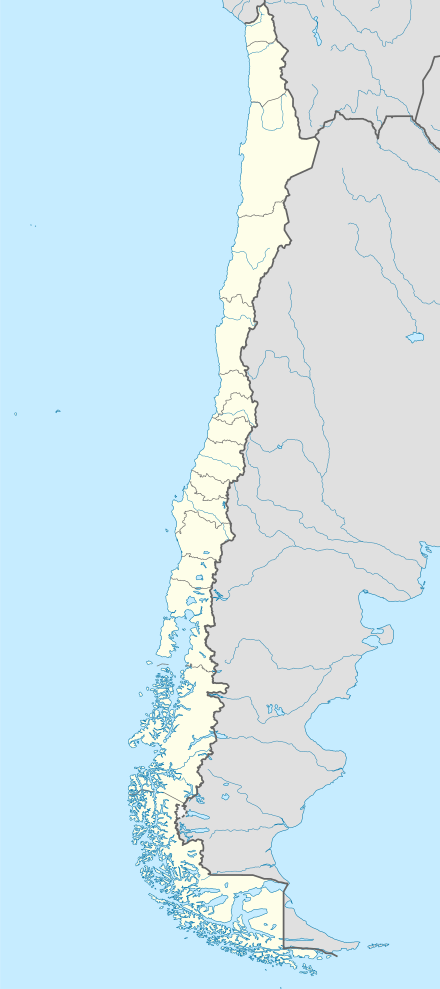Huilliche uprising of 1792
The Huilliche uprising of 1792 was an indigenous uprising against the Spanish penetration into Futahuillimapu, territory in southern Chile that had been de facto free of Spanish rule since 1602. The first part of the conflict was a series of Huilliche attacks on Spanish settlers and the mission in the frontier next to Bueno River. Following this a militia in charge of Tomás de Figueroa departed from Valdivia ravaging Huilliche territory in a quest to punish those involved in the attacks.
Background
Beginning in the mid-18th century the Spanish enclave of Valdivia begun a period of agricultural expansion. The expansion was mainly directed to the south and was done mostly by pacific means, but hostilities with indigenous Huilliches did occur.[1] The expansion of Valdivia included a process of mestization and the purchasing of indigenous lands by criollos and transformation of previous indigenous proprietors into inquilinos.[2] In contrast the Spanish settlement at Chiloé Archipelago had a history of conflicts with the indigenous peoples north of the archipelago. After the Valdivian colonization had reached Bueno River Spanish authorities pushed for connecting the city of Valdivia with the settlements at Chacao Channel by a road. This way the Spanish authorities hoped to make its possible for Valdivia and Chiloé to offer each other mutual aid in the case of an invasion by a European power.[1]
In the 1780s when attempting to cooperate to establish the road the Governor of Valdivia Mariano Pusterla and the Intendant of Chiloé Francisco Hurtado del Pino disagreed. Hurtado del Pino preferred to militarily confront the Huilliches, while Pusterla rejected this approach.[3] As Hurtado del Pino was removed from his position and replaced by Francisco Garos cooperation ensued.[3] In October 1788 Pusterla sent an expedition to traverse the Huilliche-ruled territories to reach Chiloé. The expedition proved successful and by February 1789 its men were back in Valdivia.[4] After this Pusterla made arrangements to improve the path to Chiloé, in particularly to widen it at places is was a narrow track along forests.[4] In a parliament the Spanish held with local Cuncos and Huilliches Pusterla assured that the opening of the road would not imply a reestablishment of the city of Osorno.[4][upper-alpha 1] subsequently the safe transit along the road came to depended on the goodwill of local tribes.[4]
Uprising
The uprising begun in September 1792, with a series of assaults against Spanish settlers in Río Bueno and Lago Ranco.[5] Houses were torched and animals stolen. Ten Spanish settlers are reported to have been killed.[5] Spanish messengers and priests were caught off guard and brutally killed.[6] Spanish refugees escaped north reaching Valdivia.[6] Once authorities realised it was an uprising and not ordinary crime a detachment in charge of Tomás de Figueroa was sent south from Valdivia on October 3, following Futa River.[6] The first step of the campaign was to Daglipulli where the militia of Figeroa was to absorb the 22 soldiers stationed to reach a total of 104 men.[6]
When Figueroa reached the conflict zone the local Huilliches presented themselves as friends.[7] Deeming this to be a tactic to avoid retribution Figueroa had local cacique Manquepán executed along his two sons and seventeen of his men.[7] These men rejected baptism before their death.[8] Subsequently, the Spanish took custody of women and children, while animals were confiscated.[9] Next on the militia continued to cross Bueno River. Thereafter it advanced slowly amidst heavy rains, obstacles put in their way and minor ambushes.[9] Figueroa reached the ruins of Osorno on November 22, the view of which made a strong impression on him.[9] The campaign continued to ravage Huilliche territory in pursuit of rebel elements until it arrived back to Valdivia on January 14, 1793.[10]
Aftermath
After the Spanish had suppressed the uprising Royal Governor of Chile Ambrosio O'Higgins summoned local chiefs to the Parliament of Las Canoas.[11] The parliament is historically relevant since the treaty signed at the end of the meeting allowed the Spanish to reestablish the city of Osorno and secure the transit rights between Valdivia and the Spanish mainland settlements next to Chiloé Archipelago (Carelmapu). The indigenous signatories recognized the king of Spain as their sovereign but they kept considerable autonomy in the lands they did not ceded.[12]
Notes
- The city of Osorno had originally been founded by the Spanish in 1558 but was destroyed by Cuncos and Huilliches in 1602 during the destruction of the Seven Cities.
References
- Couyoumdjian, Juan Ricardo (2009). "Reseña de "La frontera de arriba en Chile colonial. Interacción hispano-indígena en el territorio entre Valdivia y Chiloé e imaginario de sus bordes geográficos, 1600-1800" de MARÍA XIMENA URBINA CARRASCO" (PDF). Historia. I (42): 281–283. Retrieved 30 January 2016.
- Illanes Oliva, M. Angélica (2014). "La cuarta frontera. El caso del territorio valdiviano (Chile, XVII–XIX)". Atenea. 509: 227–243. Retrieved 30 January 2016.
- Barros Arana 2000, p. 49.
- Barros Arana 2000, p. 50.
- Barros Arana 2000, p. 65.
- Barros Arana 2000, p. 66.
- Barros Arana 2000, p. 67.
- Barros Arana 2000, p. 68.
- Barros Arana 2000, p. 69.
- Barros Arana 2000, p. 70.
- Alcamán, Eugenio. "El parlamento general de Las Canoas" (in Spanish).
- Contreras Painemal, Carlos (2011). "Los Tratados celebrados por los Mapuche con la Corona Española, la República de Chile y la República de Argentina". Retrieved 3 December 2013. Cite journal requires
|journal=(help)
Bibliography
- Barros Arana, Diego (2000) [1886]. "Capítulo XVII". Historia General de Chile (in Spanish). VII (2 ed.). Santiago, Chile: Editorial Universitaria. ISBN 956-11-1535-2.CS1 maint: ref=harv (link)
